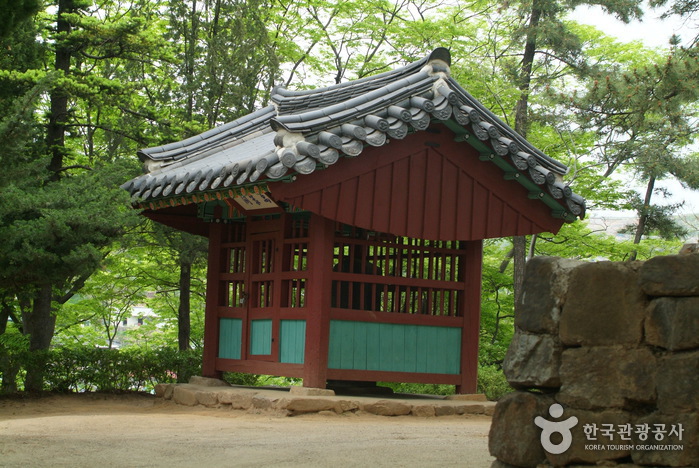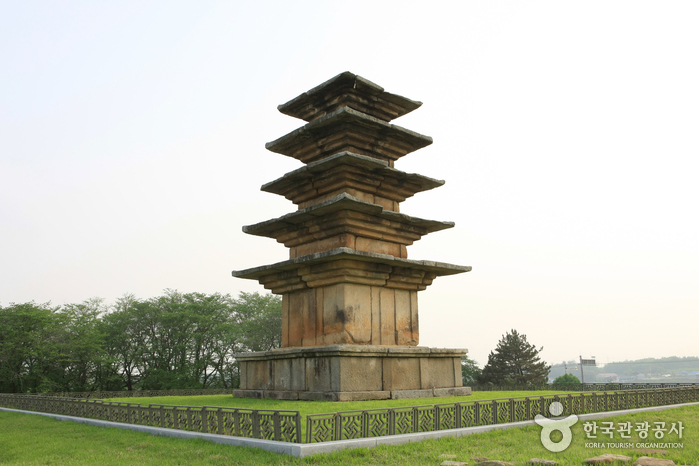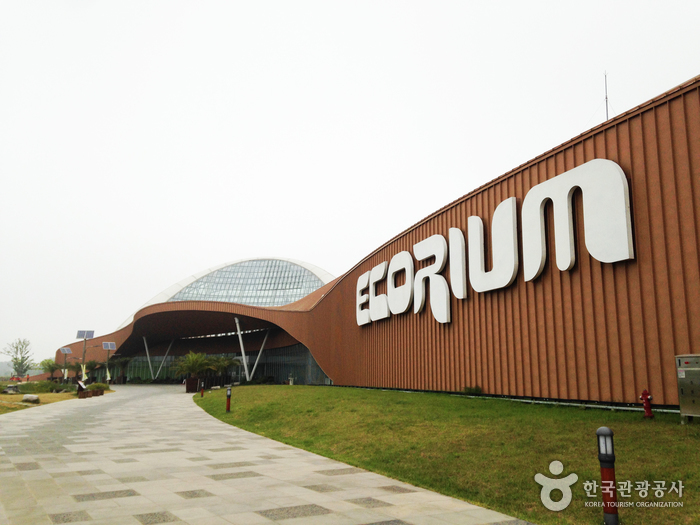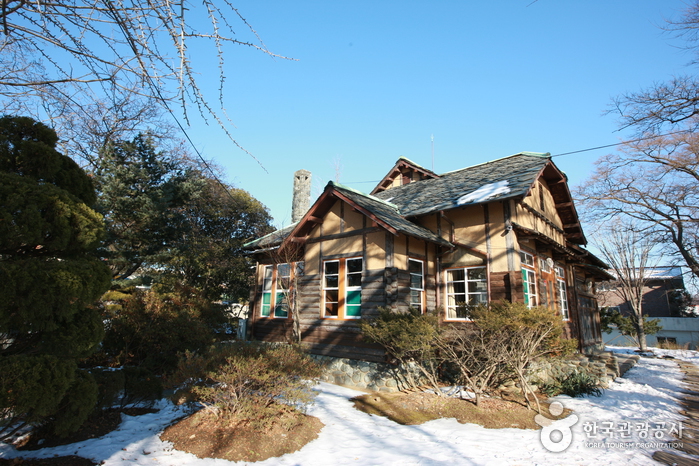Samcheok Cheokjudonghaebi & Pyeongsutochanbi Monuments (삼척 척주동해비 및 평수토찬비)
17.3 Km 10614 2023-04-18
13-7, Heomok-gil, Samcheok-si, Gangwon-do
+82-33-859-5708
Erected by Heo Mok, the governor of Samcheok during the second year of King Hyeonjeong's reign (1661), Cheokjudonghaebi Monument is 170 centimeters tall. It was originally built to protect the village on Mallido Island that had been frequently inundated by heavy rain and rough waves. It is believed that the mystical inscription, penned by Heo Mok, on the monument calmed the rough sea waves. Today, the monument stands to prove the wisdom and distinguished penmanship of the former Samcheok City Governor.
Pyeongsutochan-bi Monument is 145 centimeters tall. It was erected by Heo Mok's successor and former governor of Samcheok, Jung Un-cheol, in reverence for his wise forebear. The monument contains
48 ancient Chinese characters that describe many achievements of Heo Mok.
Wanggung Five-story Stone Pagoda (익산 왕궁리 오층석탑)
17.3 Km 9847 2024-04-07
San 80-1, Wanggung-ri, Wanggung-myeon, Iksan-si, Jeonbuk-do
+82-63-859-5708
The Wanggung Five-story Stone Pagoda is located on a hill about 2 kilometers south of Wanggung-myeon in Iksan, which is believed to have been the capital of the nation during the Mahan Era. The pagoda stands tall at 8.5 meters and was officially designated as a National Treasure. Relics from the Goryeo dynasty that were found inside the pagoda were designated as a National Treasure and are currently housed in the National Museum of Korea. Of the excavated relics, the most famous; the Sarijangeomgu, a magnificent container of Buddha’s Sarira; the green glass Sarira bottle topped with a lotus-shaped stopper; and the Sungeumgeumganggyeongpan, which contains the 19 golden plates of the Diamond Sutra.
Deoksugung Haemul Kalguksu (덕수궁해물칼국수)
17.3 Km 20616 2024-02-28
5, Jangsan-ro 855beon-gil, Maseo-myeon, Seocheon-gun, Chungcheongnam-do
041-956-7066
Located near the Geumgang Estuary Embankment, Deoksugung Haemul Kalguksu serves haemul kalguksku (noodle soup with seafood) full of clams and vegetables. Kalguksu (noodle soup) is made by rolling out a thin flour dough, slicing it into thin strips, and then boiling them in a soup. There’s a variety of kalguksu (noodle soup) dishes on offer, along with wangmandu (jumbo mandu). The broth is clean, thanks to shrimp and fresh vegetables. Don’t miss yeolmu kimchi (young summer radish kimchi), which is served as a side dish in the restaurant and goes perfectly with kalguksu (noodle soup).
Archaeological Site in Wanggung-ri [UNESCO World Heritage] (익산 왕궁리유적 [유네스코 세계문화유산])
17.5 Km 26591 2024-04-07
666, Gungseong-ro, Iksan-si, Jeonbuk-do
+82-63-859-4631
Archaeological Site in Wanggung-ri, designated as Historic Site No. 408 on September 17, 1998, has a surface area of 216,862 square meters. The site has various structures and artifacts from Baekje dynasty to unified Silla period. Artifacts were found within the rectangular-shaped fortress site that surrounds Wanggungri Five-story Stone Pagoda, National Treasure No. 289.
National Institute of Ecology - Seocheon (국립생태원(서천))
17.9 Km 15479 2020-05-18
1210, Geumgang-ro, Seocheon-gun, Chungcheongnam-do
+82-41-950-5300
National Institute of Ecology is a research, exhibition, and educational center housing various animals and plants from world five climates and regions including the tropics, desert climate, the Mediterranean, temperate climate, and the polar region. Fauna and flora from the Korean Peninsula's ecosystem can also be seen here. The Institute’s Ecorium showcases living ecosystem exhibitions, housing 1,900 plants and 280 animals in an area of 21,000㎡ to help people understand the relations between climate and ecology. The outdoor exhibition area is divided into 5 sections, from Korea’s representative wetland ecological system to various international plants, rare plants grown on the high mountain, Korean representative deer species' habitat space, pond ecology and others. In addition, it offers vivid ecological education through the nearby ecological region and has varied exhibitions and researching facility as well as firsthand programs and events.
House of Lee Young-choon (이영춘가옥)
18.5 Km 28660 2024-04-07
7, Donggaejeong-gil, Gunsan-si, Jeonbuk-do
+82-63-454-3922
The House of Lee Young-choon was constructed by
a Japanese landlord named Kumamoto during the Japanese colonial era. The house combined Western, Korean, and Japanese into one structure. After Korean liberation, Dr. Lee Young-choon, the first medical doctor, lived in the house. From that time, the house was referred to as the
House of Lee Young-choon.
Thanks to its beautiful exterior, the house was used as a backdrop for films such as Bingjeom, Sandglass, and Yain Shidae, etc.
The doctor was considered the Korean "Albert Schweitzer", and his
pen name of "Ho", referring to ssangcheon,
means "two branches of spring water, represents one for healing physical disease and the other for healing the
spirit. He was born in Yonggang-gun, Pyeongannam-do in October 1903. In 1935,
through a connection by his professor at Pyeongyanggobo School, he took a position
as the head of Jahye Hospital to take care of 20,000 people. In addition, he was the first person
in Korea to implement the policy of school nurses as well as the medical insurance union.
Surawon (수라원)
18.9 Km 21068 2024-02-26
641-9, Jangsan-ro, Janghang-eup, Seocheon-gun, Chungcheongnam-do
0507-1435-6250
Surawon is a hanu (Korean beef) and bulgogi restaurant located at the estuary where the Geumgang River meets the Yellow Sea, allowing visitors to have a great view of the sea, the river, tidal flats, and the city of Gunsan beyond the river. The menu includes seoksoe bulgogi (grilled bulgogi), dwaeji galbi jjim (braised pork galbi), so galbi jjim (braised beef galbi), and hanu gui (grilled Korean beef). The nearby Geumgang Estuary Embankment is famous for the view of thousands of migratory birds dancing above the water, while the city of Gunsan across the Dongbaekdaegyo Bridge is known for its modern architecture and historical sites.
Wanggung Dawon (왕궁다원)
19.3 Km 0 2024-04-07
21-5 Sagok-gil, Wanggung-myeon, Iksan-si, Jeonbuk-do
Wanggung Dawon is a hanok café built in the 1800s. It was once the residence of Song Byungwoo, a rich person in the region, and has been operating as a traditional tea house since 2008, preserving the charm of the old hanok. The café offers a wide variety of teas, with the signature menu item being ssanghwatang (herbal tonic tea), a traditional Korean beverage. Ssanghwatang is made with ingredients such as jujube, ginseng, and chestnuts, known for its warming properties.
Adidas - Lotte Mall Gunsan Branch [Tax Refund Shop] (아디다스 롯데몰군산)
19.5 Km 0 2024-04-17
130, Jochon-ro, Gunsan-si, Jeollabuk-do
-
Uniqlo - Lotte Mall Gunsan Branch [Tax Refund Shop] (유니클로 롯데몰군산)
19.5 Km 0 2024-04-18
1F, 130, Jochon-ro, Gunsan-si, Jeollabuk-do
-



![Archaeological Site in Wanggung-ri [UNESCO World Heritage] (익산 왕궁리유적 [유네스코 세계문화유산])](http://tong.visitkorea.or.kr/cms/resource/97/2514197_image2_1.jpg)


![Adidas - Lotte Mall Gunsan Branch [Tax Refund Shop] (아디다스 롯데몰군산)](http://tong.visitkorea.or.kr/cms/resource/78/2888278_image2_1.jpg)
![Uniqlo - Lotte Mall Gunsan Branch [Tax Refund Shop] (유니클로 롯데몰군산)](http://tong.visitkorea.or.kr/cms/resource/14/2888414_image2_1.jpg)
 English
English
 한국어
한국어 日本語
日本語 中文(简体)
中文(简体) Deutsch
Deutsch Français
Français Español
Español Русский
Русский